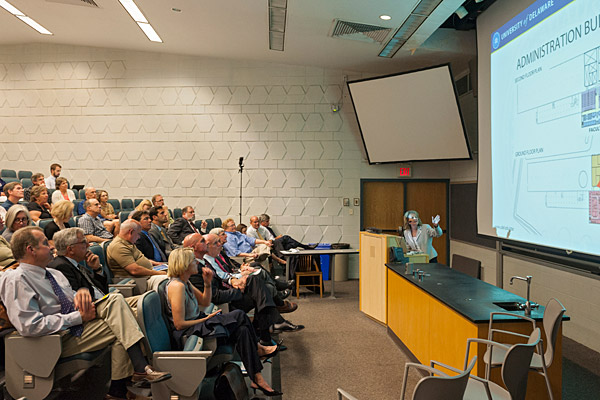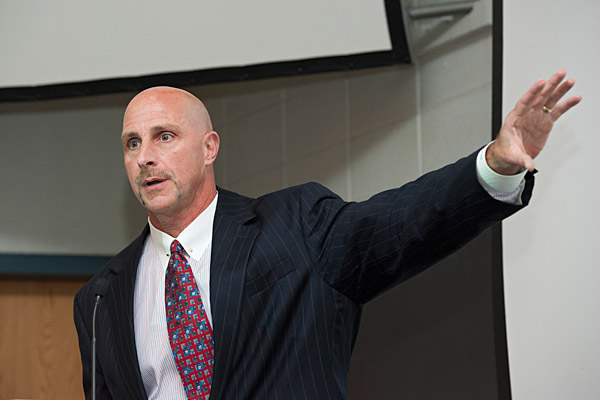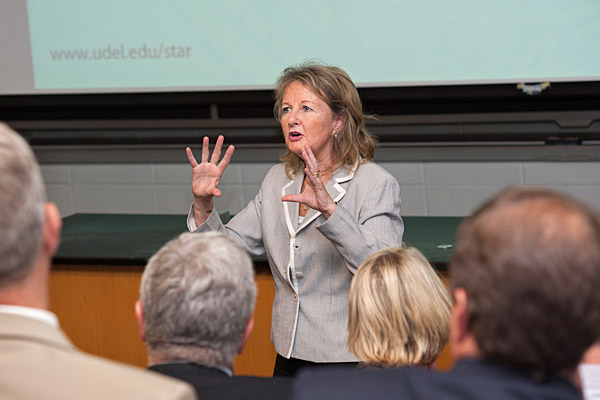A campus for the future
STAR Campus to enhance research, innovation possibilities
2:25 p.m., June 1, 2012--A crowd of more than 100 gathered Tuesday afternoon, May 29, in Sharp Lab for the first Science, Technology and Advanced Research (STAR) Campus town hall meeting.
The forum highlighted not only the milestones since the University of Delaware’s purchase in November 2009 but also the announcement of a strategic partnership with Delle Donne and Associates and Bancroft Construction Company and UD’s “3+1” strategy for developing the site into a campus where academics, innovation, research and partnerships will thrive.
Campus Stories
From graduates, faculty
Doctoral hooding
While the STAR Campus has been a construction site for the last two years, Scott Douglass, executive vice president and University treasurer, explained the University has already hosted numerous events on the campus and forged partnerships that will have a permanent home on the site. “Last fall, we announced eV2g -- a joint venture with NRG to build electric cars -- and just in April we broke ground with Bloom Energy as it will be constructing its first East Coast manufacturing facility on the STAR Campus.”
These partnerships along with others such as the U.S. Army at Aberdeen Proving Ground, Fraunhofer Center for Molecular Biology and BADER Consortium are key components to the University’s “3+1” strategy for developing the STAR Campus. The strategy focuses on energy and the environment, national security and defense, as well as health and life sciences plus enabling transportation infrastructure.
“We want to align our strategic priorities with opportunities,” said Mark Barteau, senior vice provost for research and strategic initiatives. Barteau explained UD is a Category 1 research institution that has brought in multiple multimillion dollar research awards, and this “3+1” strategy enables UD to leverage its strength with location and transportation as well as academics, research and partnerships.
With phase one of the STAR Campus development focusing on the former Chrysler administration building, which will be utilized for health and life sciences, Kathy Matt, dean of the College of Health Sciences envisions this campus as a health community for a healthy community.
“We have the opportunity to create a campus where you can live, work and be healthy,” said Matt. Prospective health science tenants include the Delaware Health Sciences Alliance, UD’s Department of Physical Therapy and the Nurse Managed Health Center, as well as clinics and laboratories, biomedical and biotechnology companies and fitness facilities and outdoor trails. “It is going to take energy and vision to make this happen.”
Ernest Delle Donne, president of Delle Donne and Associates, will be developing the former administration building, which accounts for about 15 acres on the 272-acre campus. “We are here to guide the University -- ensuring that we bring in the right tenants that fit into their plans and enhance the experience and opportunities for collaboration on the STAR Campus,” Delle Donne said.
Development of the STAR Campus will start along South College Avenue and continue to move inward on the site, according to Andy Lubin, UD’s director of real estate. The timeline for phase one will be approximately 16 to 18 months, with the anticipated opening of the former administration building in January 2014.
While the health sciences complex will be constructed first, David Singleton, vice president of facilities and auxiliary services, said it could take 40 or even 50 years for the site to be fully developed. As the last large open space adjacent to the University for development, the STAR Campus strategy will be organic as well as economically feasible, which requires patience and strategic thinking.
“We hope the STAR campus can be a place for strategic partners to build facilities that our students and faculty can take advantage of for further research and innovation opportunities,” said Douglass.
Similarly, the Delaware Technology Park (DTP), which is also adjacent to the University of Delaware, has been a small-scale model, showcasing how to build a focused and successful research and tech park. Mike Bowman, president and chairman of DTP, explained how university research parks are communities of innovation.
While DTP is building a sixth and final building on its site along Wyoming Road, it has had great success, building more than 80 companies. “One of our most successful companies at the tech park is QPS,” Bowman said. “They started with two people and now have hundreds of employees. But we’ve reached capacity at the park.”
Bowman said his hope is to bring some of those companies that have been successful at the Delaware Technology Park over to the STAR Campus, where there is room for them to grow.
This model also fits with Matt’s plans for the College of Health Sciences. “As programs grow with outreach pieces for companies,” Matt said, “we’ve talked about having some programs incubate at the Delaware Technology Park and then when they are fully developed, bring them to the STAR Campus.”
Article by Meredith Chapman
Photos by Evan Krape













